| WAT NOK 1 (วัดนก) |
| Wat Nok is a restored monastery located within the Ayutthaya Historical Park. It can easily be found on the southwestern corner of Wat Maha That. Given such a close location, Wat Nok is sometimes mistaken as part of Wat Maha That though it has its own distinct style and history. Wat Nok is situated in an east/west axis. In situ at Wat Nok are the remains of a preaching hall and a large prang-like chedi. The ubosot consists of a basic foundation and renovated traces of its walls and pillars. There are several headless Buddha images on its altar - all in Taming Mara poses. The prang-like chedi reflects the Khmer style, but its multiple redented corners and elaborate portico (with secondary prang) are suggestive of the late-Ayutthaya period. There is a staircased-entrance on the eastern side, but nothing is visible inside except for bat droppings. The prang has some of the best preserved stucco in the city. There are many geometric designs visible and a number of preserved images. A few niches have partial remains of standing Buddha images and one of the redented corners has a statue of some headless mythological figure. On the southern side there are traces of Rahu eating the sun. There isn’t a clear record of this temple’s construction date, but King Maha Thammaracha (r. 1569-1590) persuaded a Mon monk to live here around 1584 - the Great Holy Tera Khan Chong. This honor was in reward for his role in Prince Naresuan's winning independence from the Burmese. Royal Chronicles describe this story in great detail. While still technically allied with the King Honsawadi of Burma, Prince Naresuan marched his troops to the city of Khraeng, where they encamped near the monastery of the Great Holy Tera Khan Chong. King Honsawadi, in the meantime, set up a plan to betray Prince Narasuaen - sending out an army of 10,000 to ambush and kill him. Two Mon military leaders, Phraya Kiat and Phraya Ram, were ordered to attack Prince Naresuan’s troops and execute him (Cushman 88). However, the Great Holy Tera Khan Chong was informed of this treachery and took pity on Prince Naresuan. He arranged a meeting between Phraya Kiat, Phraya Ram, and Prince Naresuan in which all was revealed. As a result, Prince Naresuan declared revenge and announced that the two kingdoms "shall be totally divorced from each other from this day to the end of kalpa." (Cushman 89). He promised to escort the two Mon leaders and the Holy reverent to the safety of Ayutthaya – fighting together against the Burmese along the way. While leading the Great Holy Thera Khan Chong and his relatives - and the families of Phraya Kiat and Phraya Ram - back to Ayutthaya, Prince Naresuan defeated the enraged Burmese in battle and Ayutthaya became independent once again. King Maha Thammaracha (1569-1590), the father of Prince Naresuan, rewarded the Mon families in gratitude. Phraya Kiat and Phraya Phra Ram were directed to reside in the vicinity of the Khamin Village and Wat Khun Saen. The relatives of Tera Khan Chong were sent to live in a village behind Wat Nok (Cushman 90). This Mon areas stretched all the way from Wat Nok to Wat Phong. It is highly likely that Thera Khan Chong served as the abbot of Wat Nok. |

| Text & photographs by Ken May - August 2009 |
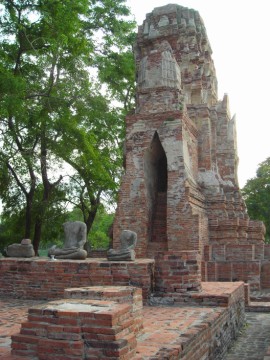
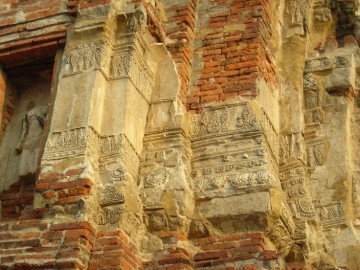
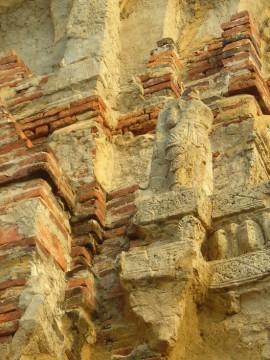
| (View of Wat Nok) |
| (Remaining stucco work) |
| (Remaining stucco work) |
| Addendum The Mon priest Thera Khan Chong did not serve as abbot of Wat Nok as written above, but was installed at Wat Maha That. King Maha Thammaracha (r. 1569-1590) had the Village Dwelling Sect split up in two assemblies being a Division of the Left and a Division of the Right. Therea Khan Chong became the patriarch of the Division of the Left, while the original patriarch Wannarat administered the other division. The relatives of Thera Khan Chong were directed to live in the vicinity of a village behind the Nok Monastery. [1] "When the Royal Father and King Naresuan had finished making their plans together, the King was pleased to have the great holy Thera Khan Chòng located at Maha That Monastery as His Holiness Ariyawong, abbot of the Village Dwelling Sect residing at Phra Si Rattana Maha That Warawihan Royal Monastery, and bestowed on him a sappathon umbrella, a kanching umbrella, a palanquin, bearers, rice, an annual bounty, and the various eight requisites of a Buddhist monk. Now, the King was pleased to have the position of His Holiness Wannarat, the original Patriarch of the Village Dwelling Sect, administer only the Assembly of the South as the Division of the Right; the separation of the Village Dwelling Sect into two assemblies originated at that time and has continued right down to the present." In the Late Ayutthaya period there were shops of Thai and Mon selling bowls, trays, salvers and all kinds of brassware behind Wat Nok and in front of Wat Phong. In the area there was also a fresh market called the Mon Market. [2] The restored ruin of Wat Nok is located in geographical coordinates: 14° 21' 22.01" N, 100° 34' 0.13" E. References: [1] The Royal Chronicles of Ayutthaya - Richard D. Cushman (2006) - page 90 / Source: Phan Canthanumat, British Museum, Reverend Phonnarat, Phra Cakkraphatdiphong & Royal Autograph - Naresuan and Hongsawadi Fight, and Naresuan Returns to Ayutthaya. [2] Markets and Production in the City of Ayutthaya before 1767: Translation and Analysis of Part of the Description of Ayutthaya - Chris Baker - Journal of the Siam Society, Vol. 99, 2011 - page 65. |
| Addendum, maps & photo slide show by Tricky Vandenberg Updated April 2016 |
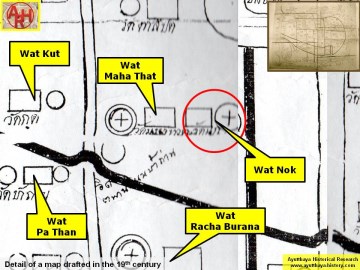
| (Detail of a 19th century map - Courtesy of the Sam Chao Phraya Museum) |

| (Detail of Phraya Boran Rachathanin's map - Anno 1926) |
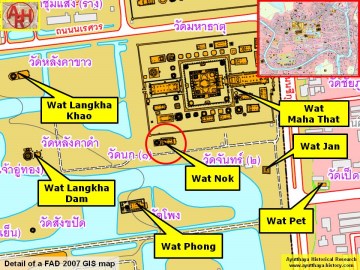
| (Detail of a 2007 Fine Arts Department GIS map - Courtesy of the Fine Arts Department - 3th Region) |
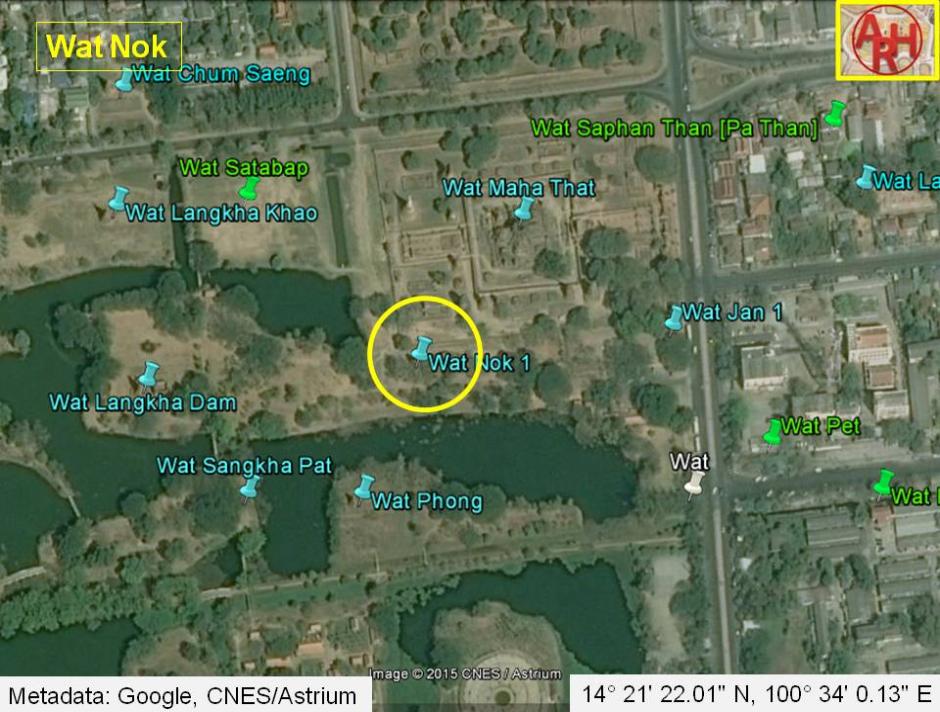
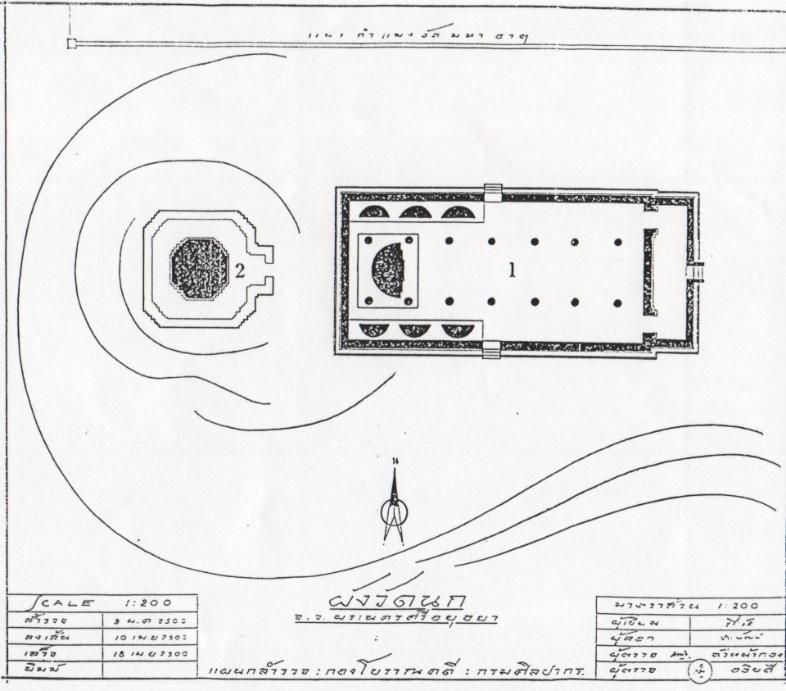
| Source: Phra Rachawang Lae Wat Boran Nai Changwat Phra Nakhon Ayutthaya (2511 BE) |